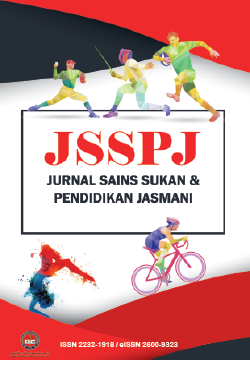Exercise as A Non-Pharmacological Approach in Managing Hypertension in Malaysia: A Narrative Review
DOI:
https://doi.org/10.37134/jsspj.vol11.1.3.2022Keywords:
Physical activity, Exercise, Hypertension, High blood pressure, PreventionAbstract
The management of high blood pressure has included both pharmaceutical and non-pharmacological approaches. Despite the fact that anti-hypertensive medications efficiently lower blood pressure, the expense of health care is growing and is likely to continue to rise in the future. This article review emphasizes the usefulness of exercise modalities as an essential non-pharmacological tool and acceptable preventive measures that can be used to the treatment of hypertension in Malaysia.
Downloads
References
ACSM. (2018). ACSM’s guidelines for exercise testing and prescription (D. Riebe, J. K. Ehrman, G. Liguori, M. Magal, & M. A. C. of Sports (eds.); 10th ed.). Wolters Kluwer.
Borjesson, M., Onerup, A., Lundqvist, S., & Dahlof, B. (2016). Physical activity and exercise lower blood pressure in individuals with hypertension: Narrative review of 27 RCTs. British Journal of Sports Medicine, 50(6), 356–361. https://doi.org/10.1136/bjsports-2015-095786
Chu, A. H. Y., & Moy, F. M. (2014). Association between physical activity and metabolic syndrome among Malay adults in a developing country, Malaysia. Journal of Science and Medicine in Sport, 17(2), 195–200. https://doi.org/10.1016/j.jsams.2013.04.003
Cornelissen, V. A., & Smart, N. A. (2013). Exercise training for blood pressure: a systematic review and meta-analysis. Journal of the American Heart Association, 2(1), 1–9. https://doi.org/10.1161/JAHA.112.004473
Dassanayake, S., Sole, G., Wilkins, G., & Skinner, M. (2020). Exercise: a therapeutic modality to treat blood pressure in resistant hypertension. Physical Therapy Reviews, 0(0), 1–10. https://doi.org/10.1080/10833196.2020.1733781
Huei Phing, C., Abu Saad, H., Barakatun Nisak, M. Y., & Mohd Nasir, M. T. (2017). Effectiveness of physical activity intervention among government employees with metabolic syndrome. Journal of Exercise Science and Fitness, 15(2), 55–62. https://doi.org/10.1016/j.jesf.2017.07.003
Institute for Public Health. (2019). National Health and Morbidity Survey (NHMS) 2019: Non-communicable diseases, healthcare demand, and health literacy—Key Findings. In Ministry of Health, Malaysia.
Loh, K. W., Rani, F., Chan, T. C., Loh, H. Y., Ng, C. W., & Moy, F. M. (2013). The association between risk factors and hypertension in perak, Malaysia. Medical Journal of Malaysia, 68(4), 291–296.
Millar, P. J., McGowan, C. L., Cornelissen, V. A., Araujo, C. G., & Swaine, I. L. (2014). Evidence for the role of isometric exercise training in reducing blood pressure: Potential mechanisms and future directions. Sports Medicine, 44(3), 345–356. https://doi.org/10.1007/s40279-013-0118-x
Ministry of Health Malaysia. (2018). Clinical Practice Guideline: Management of hypertension.
Moreau, K. L., Degarmo, R., Langley, J., McMahon, C., Howley, E. T., Bassett Jr, D. R., & Thomson, D. L. (2001). Increasing daily walking lowers blood pressure in postmenopausal women. Medicine & Science in Sports & Exercise, 33(11), 1825–1831.
Sosner, P., Guiraud, T., Gremeaux, V., Arvisais, D., Herpin, D., & Bosquet, L. (2017). The ambulatory hypotensive effect of aerobic training: a reappraisal through a meta-analysis of selected moderators. Scandinavian Journal of Medicine and Science in Sports, 27(3), 327–341. https://doi.org/10.1111/sms.12661
Tenaga Nasional Berhad. (2020). Corporate Responsibility.





